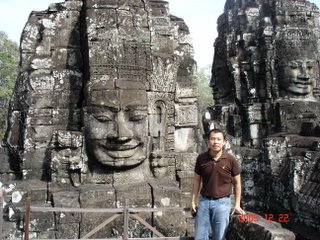Serene smiling faces at Bayon Temple

This is quite a Kodak moment! A throng of tourists packed the front of these smiling faces carved on stones to strike a pose. Bayon Temple is another highlight of my Cambodia trip besides the Angkor Wat (among the pantheon of world's seven wonders) and Banteay Srei. The bas-reliefs here best illuminate the importance to avoid the pitfall of assuming that the ancient Angkor state was preoccupied only with religious matters, important as they were. These bas-reliefs show the daily lives of the Cambodians: a woman dilivered a baby, a group of friends gathered around to barbeque (yes, BBQ!), etc. The tower of gold at Bayon used to dominate the center of Angkor as a landmark. The serene faces still look into the distance now, although now the color of sandstone rather than gold. A Buddha statue used to grace the temple until a Shivaite came to destroy or modify every image of Buddha he could lay his hands on. Many smaller shrines at Bayon were swept away and the site was modified to become a temple to Shiva. That is why tourists will see both lotus-shaped towers and lingas.
0 Comments:
Post a Comment
<< Home